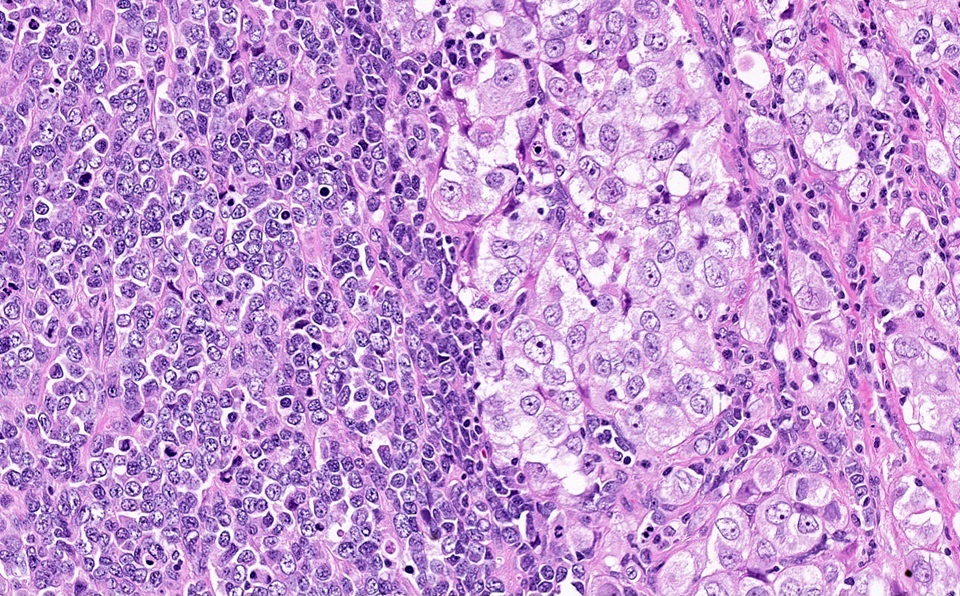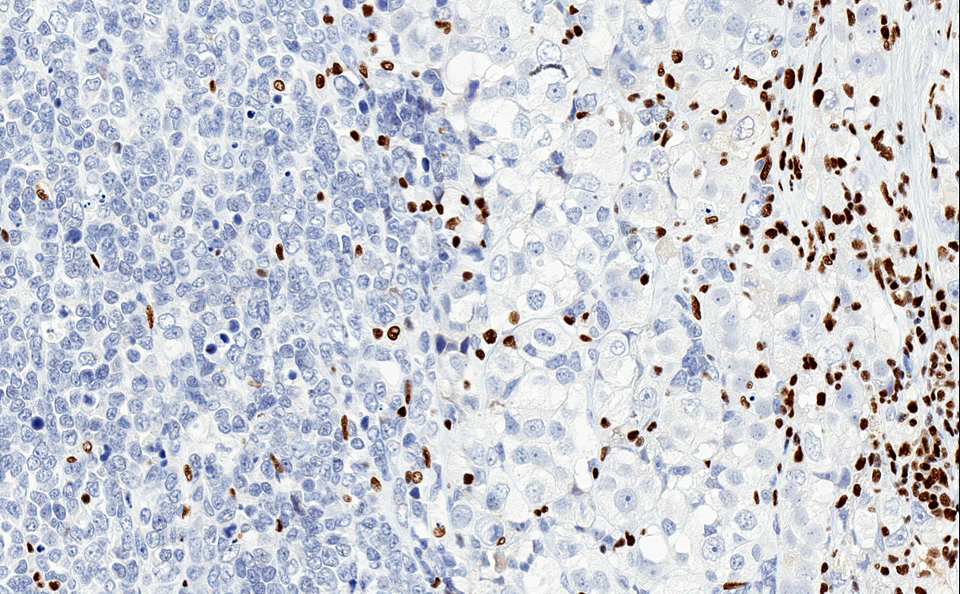Table of Contents
Definition / general | Essential features | Pathophysiology | Clinical features | Interpretation | Uses by pathologists | Prognostic factors | Microscopic (histologic) images | Positive staining - normal | Positive staining - disease | Negative staining | Molecular / cytogenetics description | Sample pathology report | Practice question #1 | Practice answer #1Cite this page: Armstrong SM, Dickson BC. SMARCA4 / BRG1 . PathologyOutlines.com website. https://www.pathologyoutlines.com/topic/stainssmarca4brg1.html. Accessed August 25th, 2025.
Definition / general
- SMARCA4 (SWI / SNF related, matrix associated, actin dependent regulator of chromatin, subfamily A, member 4) encodes a protein involved in chromatin remodeling, which is important for regulating the binding of transcription factors to DNA (also known as BRG1 and hSNF2β, among others) (HGNC: Symbol Report for SMARCA4 [Accessed 8 December 2022], NIH: SMARCA4 [Accessed 8 December 2022])
- As an evolutionarily conserved regulator of many transcription factors, it is important in mammalian tissue development and differentiation (Trends Genet 2007;23:403, Mol Cell Biol 2011;31:2618)
Essential features
- Loss of SMARCA4 characterizes several distinct neoplasms, including small cell carcinoma of the ovary hypercalcemic type, SMARCA4 deficient undifferentiated uterine sarcoma and SMARCA4 deficient thoracic tumors, among others (Mod Pathol 2018;31:1442, Am J Surg Pathol 2016;40:395, Nat Genet 2015;47:1200, J Thorac Oncol 2020;15:231, Mod Pathol 2022;35:1821)
- While SMARCA4 is considered a tumor suppressor gene, both loss of protein expression as well as protein upregulation have been associated with neoplasia (Sci Rep 2018;8:2043, Cancer Res 2003;63:560)
- It is frequently mutated in a variety of cancer cell lines (Hum Mutat 2008;29:617)
Pathophysiology
- Component of the SWI / SNF complex, which is involved in chromatin remodeling and thus the regulation of gene expression (Nature 1993;366:170, Cell Res 2011;21:396)
- Plays a role in tumor suppression directly as well as through interaction with other key cancer related proteins (BRCA1, Rb, p53, beta catenin, etc.) (Cell 2000;102:257, Cell 1994;79:119, J Biol Chem 2002;277:22330, EMBO J 2001;20:4935)
- May also play roles in DNA repair or cell cycle control (EMBO J 2010;29:1434, Cell Death Dis 2017;8:e2607)
Clinical features
- Heterozygous germline SMARCA4 mutations are associated with an autosomal dominant condition known as rhabdoid tumor predisposition syndrome 2 (OMIM: Rhabdoid Tumor Predisposition Syndrome 2; RTPS2 [Accessed 8 December 2022])
- A subset of patients with Coffin-Siris syndrome, specifically CSS4, a congenital malformation syndrome, bear a heterozygous germline SMARCA4 mutation (OMIM: Coffin-Siris Syndrome 4; CSS4 [Accessed 8 December 2022])
Interpretation
- SMARCA4 has a nuclear pattern of immunohistochemical expression; SMARCA4 deficient neoplasms have complete loss of staining among tumor cells with retained expression by nonneoplastic tissues (e.g., blood vessels, lymphocytes) (Nature 1993;366:170)
- There is no established cutoff for determining high versus low expression; staining of the surrounding normal tissue has been used as a median value relative to which SMARCA4 expression may be considered increased or decreased (Int J Oncol 2013;42:403)
Uses by pathologists
- To aid in the diagnosis of ovarian small cell carcinoma, hypercalcemic type (ovarian rhabdoid tumor) (Nat Genet 2014;46:424, J Pathol 2014;233:209, Am J Surg Pathol 2015;39:1197, Am J Surg Pathol 2016;40:395)
- To aid in the diagnosis of SMARCA4 deficient thoracic tumors (Nat Genet 2015;47:1200, Mod Pathol 2017;30:1422, Am J Surg Pathol 2019;43:455, J Cancer Res Clin Oncol 2022 Sep 19 [Epub ahead of print])
- To aid in the diagnosis of SMARCA4 deficient undifferentiated uterine sarcoma (malignant rhabdoid tumor of the uterus) (Mod Pathol 2018;31:1442)
- To aid in the diagnosis of SMARCA4 deficient undifferentiated malignant neoplasms arising at other anatomic locations, including the gastrointestinal tract and skin (Am J Surg Pathol 2016;40:544, Mod Pathol 2022;35:1821)
- To aid in the diagnosis of poorly differentiated chordoma (Cancer Genet 2014;207:384, Genes Chromosomes Cancer 2018;57:89)
- To confirm the diagnosis of malignant rhabdoid tumors or epithelioid sarcoma in which SMARCB1 / INI1 expression is intact (Am J Hum Genet 2010;86:279, Am J Surg Pathol 2018;42:312)
Prognostic factors
- Concomitant loss of SMARCA4 and BRM in non-small cell lung cancer is associated with worse prognosis (Cancer Res 2003;63:560)
- Loss of expression of SMARCA4 is associated with improved prognosis in clear cell renal cell carcinoma (Oncotarget 2017;8:37423)
- Increased SMARCA4 expression is associated with worse prognosis in patients with breast invasive ductal carcinoma, hepatocellular carcinoma and clear cell renal cell carcinoma (Anticancer Res 2016;36:4873, Sci Rep 2018;8:2043)
Microscopic (histologic) images
Positive staining - normal
- Most normal tissues contain intact nuclear SMARCA4 expression
Positive staining - disease
- Most tumors typically contain intact nuclear expression
- Increased expression has been reported in melanoma, gastric cancer, glioma, prostate adenocarcinoma and colorectal cancer (Br J Dermatol 2010;163:502, Pathobiology 2001;69:315, J Cancer Res Clin Oncol 2012;138:991, Prostate 2007;67:203, Br J Cancer 2011;104:146)
Negative staining
- Small cell carcinoma of the ovary, hypercalcemic type (ovarian rhabdoid tumor) (Nat Genet 2014;46:424, J Pathol 2014;233:209, Am J Surg Pathol 2015;39:1197, Am J Surg Pathol 2016;40:395)
- SMARCA4 deficient thoracic tumors (Nat Genet 2015;47:1200, Mod Pathol 2017;30:1422, Am J Surg Pathol 2019;43:455, J Thorac Oncol 2020;15:231, J Cancer Res Clin Oncol 2022 Sep 19 [Epub ahead of print])
- SMARCA4 deficient undifferentiated uterine sarcoma (malignant rhabdoid tumor of the uterus) (Mod Pathol 2018;31:1442)
- Poorly differentiated chordoma (Cancer Genet 2014;207:384, Genes Chromosomes Cancer 2018;57:89)
- A host of other emerging SMARCA4 deficient neoplasms (Am J Surg Pathol 2022;46:1277, Mod Pathol 2022;35:1821)
- Subsets of rhabdoid tumor and epithelioid sarcoma (Am J Hum Genet 2010;86:279, Am J Surg Pathol 2018;42:312)
- Endometrial adenocarcinoma, poorly / undifferentiated (Ann Diagn Pathol 2015;19:198, Histopathology 2017;70:359)
- A subset of non-small cell lung cancer (Hum Mutat 2011;32:E1999)
- A subset of pancreatic intraductal papillary mucinous neoplasms (Hum Pathol 2012;43:585)
Molecular / cytogenetics description
- In small cell carcinoma of the ovary, whole exome sequencing demonstrated:
- Frequent loss of heterozygosity at chromosome 19, the location of SMARCA4
- Some cases with point mutations or small indels (insertion or deletion of bases) (Oncotarget 2016;7:1732)
- A subset of patients having underlying germline SMARCA4 mutations (Nat Genet 2014;46:427, Nat Genet 2014;46:438)
- In SMARCA4 deficient thoracic tumors, mRNA sequencing showed the presence of SMARCA4 gene mutations (nonsense, frameshift, missense and splice site) (Nat Genet 2015;47:1200)
Sample pathology report
- Immunohistochemical analysis of SMARCA4 / BRG1 expression (clone, dilution, automated staining platform*):
- The tissue staining pattern is intact / lost.*
- External (positive and negative) and internal (e.g., endothelial cells and lymphocytes) controls have intact staining pattern.*
- *Details to be specified / confirmed upon reporting stain.
Practice question #1
Practice answer #1




